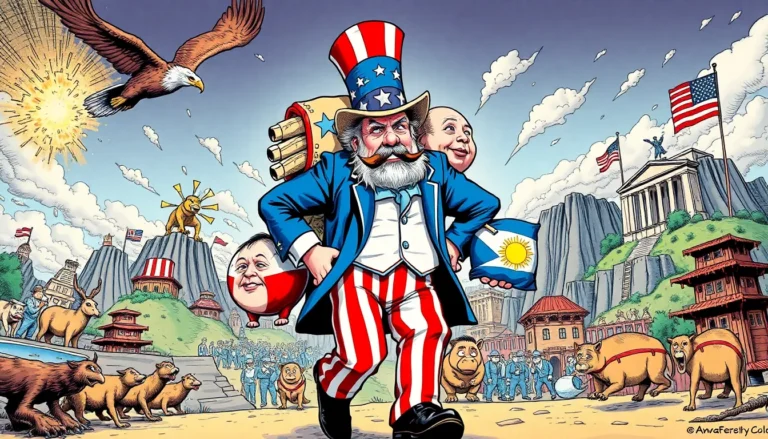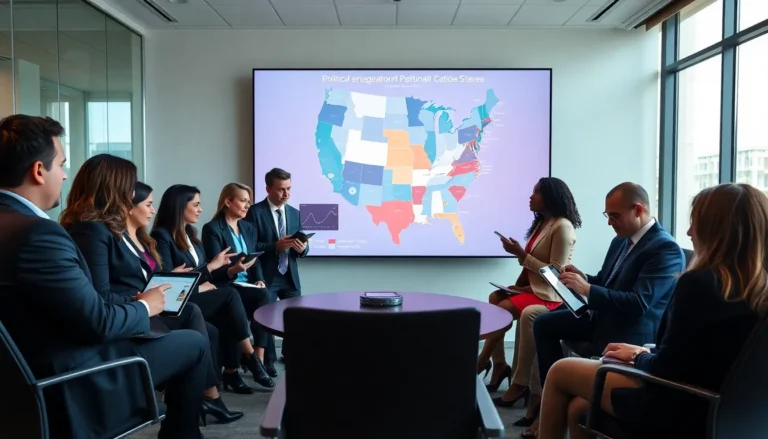When you think of political symbols, what comes to mind? Maybe it’s the soaring bald eagle, a flag waving majestically in the wind, or perhaps that cheeky donkey or elephant doing a bit of a dance. Political symbols are like the emojis of the political world, packing a heap of meaning into simple imagery. But don’t let their straightforward appearance fool you. These symbols wield immense power, shaping perceptions and influencing discourse. Let’s embark on an exploration of political symbols, digging deep into their meaning and the impact they have on society. Who knows? You might find yourself a little more visually aware the next time you tune into your favorite political show.
Table of Contents
ToggleUnderstanding Political Symbols

Political symbols serve as shorthand for complex ideas, beliefs, and identities. Essentially, they are visual representations that encapsulate the essence of a political movement or ideology. Think about it, when you see the peace sign, you instantly associate it with the anti-war movements of the 1960s. This immediate recognition illustrates how political symbols tap into collective memory and cultural associations.
The power of these symbols lies in their ability to convey messages quickly and efficiently. Whether it’s a logo, color, or mascot, each element is intentionally chosen to evoke specific emotions or reactions. For example, the colors associated with various political parties can stir feelings of loyalty or opposition before a person even reads a word. Political symbols become a framework, allowing individuals to navigate the often chaotic landscape of political discourse.
Historical Context of Political Symbols
The use of political symbols is not a modern invention: it has deep historical roots. Ancient civilizations used symbols to convey power, such as the lion, often representing kingship and authority. The Roman Empire employed the eagle to signify imperial strength. Fast forward to the 18th century, and symbols like the Liberty Bell in America emerged as emblems of freedom and independence during the American Revolution.
As the context around politics evolved, so too did the symbols. The swastika, once a symbol of good fortune in various cultures, took a dark turn under Nazi Germany, showcasing how symbols can be recontextualized and wielded for both benevolent and malevolent purposes. Understanding this historical evolution aids in understanding current political symbols and the baggage they might carry.
Types of Political Symbols
Political symbols can be broadly categorized into several types, each serving unique functions. Here are some prime examples:
- Logos: Political parties often have distinct logos that encapsulate their ideologies. For instance, the Democratic Party’s blue color scheme represents a more progressive stance, while the Republican Party often utilizes red to depict traditional values.
- Flags: Flags are perhaps the most recognizable political symbols, representing nations and movements alike. They evoke feelings of nationalism and unity.
- Icons: Icons can range from historical figures to monuments, such as the Statue of Liberty, which symbolizes hope and freedom.
- Colors: Colors alone can be powerful political symbols. The color purple is often associated with unity, bringing together conservative blue and liberal red. Each type plays a vital role in shaping political narratives and influencing public perception.
The Role of Political Symbols in Communication
Political symbols are crucial in communication, acting as a bridge between complex ideas and public understanding. They simplify information, making it more digestible for the average citizen. For example, during elections, parties will often use catchy symbols in their advertisements, like the Democratic donkey or Republican elephant, to create a quick and memorable association.
Also, symbols can evoke strong emotional responses. During moments of civil unrest, symbols like clenched fists or peace signs may emerge prominently in protests, amplifying messages of solidarity and resistance. In this way, political symbols help grassroots movements, enabling collective action and engagement.
Case Studies: Iconic Political Symbols
Several political symbols have transcended their origins to become icons in their own right.
- The Peace Sign: Created in the late 1950s, this symbol became synonymous with anti-war movements around the globe, particularly during the Vietnam War.
- Olympic Rings: Representing the unity of the five continents, these rings are symbols of global collaboration and peace, often used during political demonstrations advocating for world unity.
- The Raised Fist: Often associated with Black Power and social justice movements, this symbol represents solidarity and the struggle against oppression. Each serves as a powerful visual reminder of the struggles and aspirations of various groups.
Criticism and Controversies Surrounding Political Symbols
While political symbols serve many functions, they’re not without their controversies. Certain symbols can become divisive, as illustrated by the use of the Confederate flag in the United States. To some, it represents heritage: to others, it symbolizes racism and oppression.
Also, the appropriation of symbols can lead to misunderstandings. For example, the rainbow flag, initially representing LGBTQ+ pride, has at times been co-opted for commercial gain, which can dilute its significance. These controversies highlight how symbols can shift in meaning based on context, ownership, and social dynamics.
The Future of Political Symbols in a Changing Landscape
Looking ahead, political symbols are likely to evolve as society becomes more interconnected. As digital platforms gain prominence, symbols will take on new forms in virtual spaces. Memes and hashtags can quickly become symbols of movements in the digital age, creating a rapid-fire evolution of political representation.
Besides, with global issues such as climate change and social equity rising to the forefront, new symbols are emerging to encapsulate these causes. Expect to see a rise in symbols that reflect collective movements aimed at addressing longstanding inequities and global crises.





